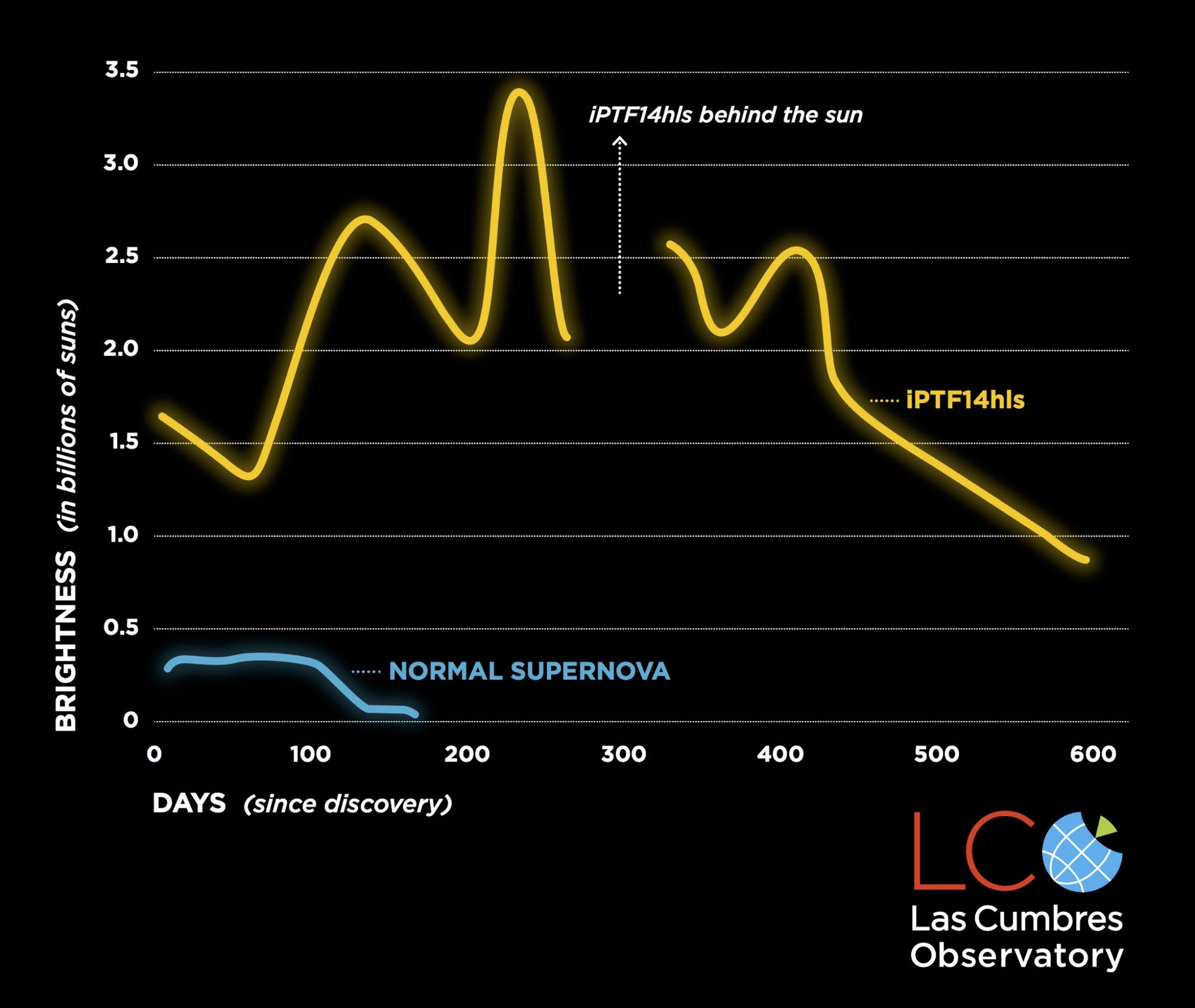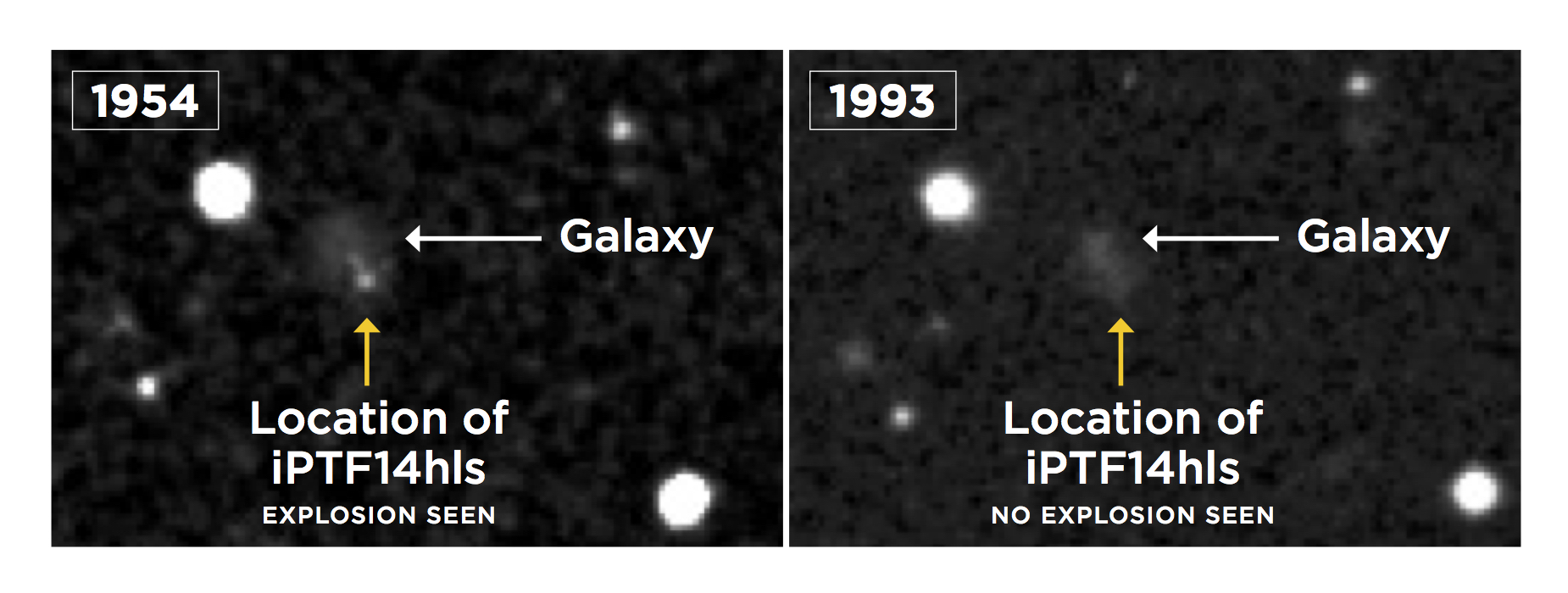‘Star That Would Not Die’ Explodes for a Record 600 Days
Credit to Author: Becky Ferreira| Date: Wed, 08 Nov 2017 18:00:00 +0000
Massive stars do not go gently to their deaths, opting instead to explode into radiant supernovae. These stellar detonations are among the brightest events in the observable universe, enabling thousands of them to be discovered and studied by astronomers.
But no known supernova has ever behaved like the one named iPTF14hls, which is described this week in Nature as “the star that would not die.”
First spotted in September 2014 by the Intermediate Palomar Transient Factory (iPTF) survey in San Diego, the luminous event was classified as a type II-P supernova involving a behemoth star at least 50 times more massive than the Sun. These catastrophic type II explosions normally shine for 130 days at the most, so astronomers were perplexed when iPTF14hls continued to sparkle well past this projected timeline.

Over the course of 600 days, the dying star cycled through brightening periods until it finally began to fade in 2016. According to a newly published Nature study led by Iair Arcavi, a NASA Einstein postdoctoral fellow at Las Cumbres Observatory (LCO) and UC Santa Barbara, this makes iPTF14hls the longest-lived supernova ever observed.
“There have definitely been long-lived supernova before, but none of them had become bright and faint again five times like this one,” Arcavi told me in an email. “That is definitely unique.”
The team proposed that one explanation for the extended death rattle could be that this event was a “pulsational pair instability supernova,” a phenomenon that has never been conclusively identified before.
Models of this scenario posit that large dying stars become destabilized by matter-antimatter creation in their cores. This causes them to erupt in “supernova imposter” events that look like full-blown star deaths, but are only partial blasts shedding much of the star’s hydrogen gas shell.
Arcavi and his colleagues discovered that in 1954, astronomers recorded a brilliant outburst from the same region as iPTF14hls, which inhabits a distant galaxy millions of light years from Earth. They suggest this blast may have been one such imposter event.

But there are plenty of holes in this theory, such as the retention of a large portion of the star’s hydrogen shell after the 1954 blast, and the oddly consistent temperature of the supernova, which hovered around 5,000 to 6,000 Kelvin (about 10,000°F).
“Current models of massive star evolution and explosion need to be modified, or a completely new picture needs to be put forward, to account for the energetics of iPTF14hls, its lack of strong interaction signatures, and the inferred amount of hydrogen it retained toward the end of its life,” the authors concluded.
To crack this mystery, astronomers are still gazing into the cinders of this bizarre supernova. “As it fades, it’s also becoming more transparent, allowing us to see further inside the supernova than we were able to before,” Arcavi explained. “We’re hoping this will reveal more clues about what has been powering it all this time.”
The Hubble Space Telescope is also scheduled to inspect the supernova’s remains next month, which could yield more insights into the deceased star’s environment. Moreover, Arcavi hopes that long-term coordinated telescope surveys, like the one that resulted in the new study, will detect other oddball supernova like iPTF14hls.
“It’s only by following it every few days for several years that we can see how really strange it is,” he said. “I just click a button [at LCO] to ask the global network of 20 telescopes to observe this supernova for me every few days for years. I don’t have to fly anywhere or call in favors, I just sit back and get the data. This supernova would have been impossible to study at this level with classical telescopes.”
“I also hope someone comes up with a new supernova model that can explain this,” he added. “Now that the data is being published, I’m sure some smart theorists will come up with new ideas!”
Get six of our favorite Motherboard stories every day by signing up for our newsletter .